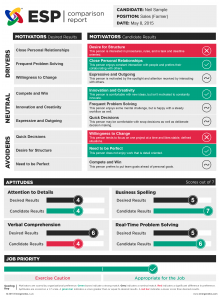
You want to minimize bad hires. That’s why your organization likely uses hiring tools. Hiring tools, such as a pre-hire assessments, can be a game changer for an organization’s hiring strategy since they go beyond the resume to tell you if a candidate possesses a certain skill or provides a measure of their abilities. But it is important to also think about the existing team and the day-to-day tasks that a candidate will be asked to perform as part of the overall team dynamic. Do your hiring tools enable you to look at the bigger picture, too?
Take for example, a project manager. Even though a project manager anywhere fulfills many of the same tasks as any other project manager, every role at every company is different. It depends on what the company does, the structure and processes of the existing team, and even the strengths of the other employees. You need to know how the perspective hire will perform within the existing framework. Your hiring tool should translate their abilities in relation to key aspects of the role, but should also be customizable to what you actually need them to do day-to-day.
Most people are familiar with Emergenetics because of our Emergenetics Profile, but as any Emergenetics Associate can tell you—you cannot use the Profile as a hiring tool. While we encourage any organization to use knowledge from the Profile in order to access the benefits of a WEteam (meaning all Emergenetics attributes are present within a team), the Profile only measures preferences, not competencies or skills. The answer is the Emergenetics Selection Program (ESP). Unlike the Emergenetics Profile, it’s a total candidate assessment that measures everything from preferences, attitudes, and motivation to bottom-line skills like logic, grammar, problem-solving and multitasking abilities.
Motivation is one of the most telling insights provided by ESP. Smart hiring is not just about selecting a person with the right skills, but they need to be engaged and stimulated by the role. It allows you to take a deeper view of a potential employee—not just what they can do, but also what are they willing to do? What will motivate them at work? How will they prioritize their tasks?
Why is this needed?
Well, let’s pretend you need to hire someone who needs to attend regular networking events, make lots of phone calls, and generally spend lots of time talking to strangers. ESP ranks certain factors from candidates, indicating to the company what will be an energy drainer or a favorite task. From the employer perspective, having understanding of the candidate’s skills and motivators (what they can do and what they are willing to do) will predict if they will be a high or low performer based on that position. And from the candidate perspective, they can take comfort in knowing that they’re being hired for a role that fits their skills and interests.
Or, think about it this way, a candidate may possess the skills needed for the role, but perhaps their abilities far outweigh the requirements of the role. They are likely to be a low performer because they do not find the tasks of the position stimulating. 6 months later you might be hiring for that position again.
ESP provides hiring managers with an accurate measure of how a candidate’s preferences and actual capabilities match the specific position requirements. It gives you the tools to narrow down a pool of qualified candidates and determine if there is a match in job compatibility and performance. The program enables organizations to scientifically identify potential bad hires through a robust measure of skills and preferences—and it enables you to find the best-fit candidate for the role.
We’re seeing two trends in the hiring space: companies acknowledging the importance of hiring for fit in addition to skill, as well as an increase in companies wanting to use Emergenetics Tools during the hiring process.
 Print This Post
Print This Post
